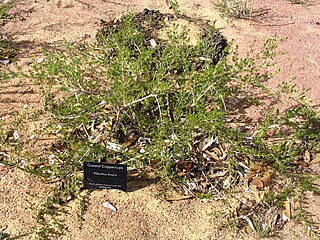| Pileanthus | |
|---|---|
 | |
| Scientific classification | |
| Kingdom: | Plantae |
| Clade: | Angiosperms |
| Clade: | Eudicots |
| Clade: | Rosids |
| Order: | Myrtales |
| Family: | Myrtaceae |
| Subfamily: | Myrtoideae |
| Tribe: | Chamelaucieae |
| Genus: | Pileanthus Labill. [1] |
Pileanthus is a genus of flowering plants in the family Myrtaceae, endemic to Western Australia. Collectively referred to by the common name coppercups, the eight currently recognised species are: [2]

Myrtaceae or the myrtle family is a family of dicotyledonous plants placed within the order Myrtales. Myrtle, pohutukawa, bay rum tree, clove, guava, acca (feijoa), allspice, and eucalyptus are some notable members of this group. All species are woody, contain essential oils, and have flower parts in multiples of four or five. The leaves are evergreen, alternate to mostly opposite, simple, and usually entire. The flowers have a base number of five petals, though in several genera the petals are minute or absent. The stamens are usually very conspicuous, brightly coloured and numerous.

Western Australia is a state occupying the entire western third of Australia. It is bounded by the Indian Ocean to the north and west, and the Southern Ocean to the south, the Northern Territory to the north-east, and South Australia to the south-east. Western Australia is Australia's largest state, with a total land area of 2,529,875 square kilometres, and the second-largest country subdivision in the world, surpassed only by Russia's Sakha Republic. The state has about 2.6 million inhabitants – around 11 percent of the national total – of whom the vast majority live in the south-west corner, 79 per cent of the population living in the Perth area, leaving the remainder of the state sparsely populated.
- Pileanthus aurantiacus [3]
- Pileanthus bellus [3]
- Pileanthus filifolius Meisn. Summer coppercups [4]
- Pileanthus limacis Labill. Coastal coppercups [1]
- Pileanthus peduncularis Endl. Coppercups [5]
- Pileanthus rubronitidus [3]
- Pileanthus septentrionalis [3]
- Pileanthus vernicosus F.Muell. [6]
Pileanthus aurantiacus is a plant species of the family Myrtaceae endemic to Western Australia.
Pileanthus bellus is a plant species of the family Myrtaceae endemic to Western Australia.
Pileanthus filifolius, commonly known as summer coppercups, is a plant species of the family Myrtaceae endemic to Western Australia.











